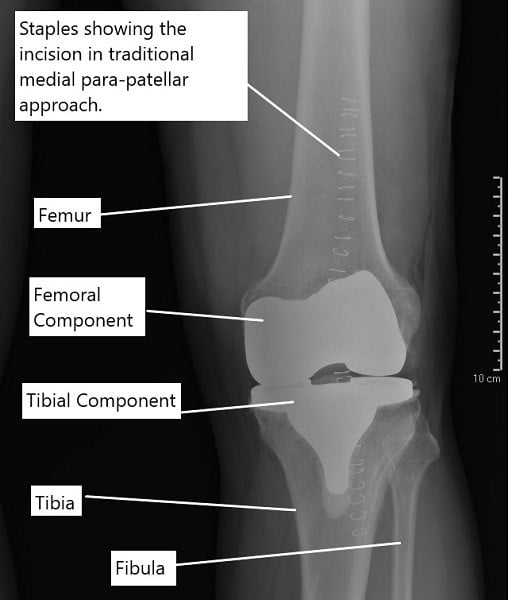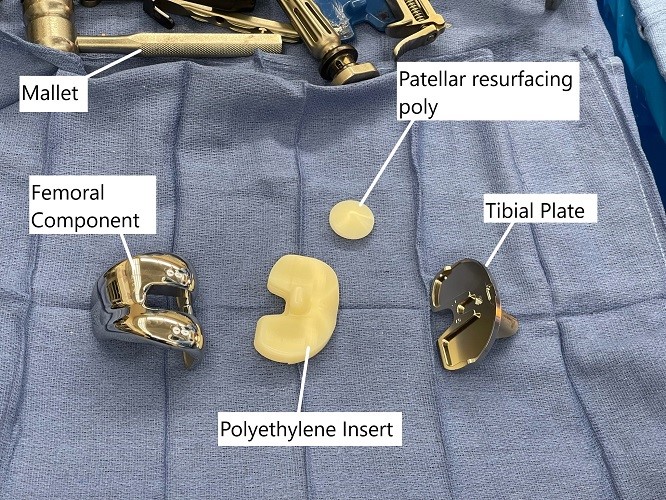Minimally Invasive Vs Total Knee Replacement
Many people occasionally experience knee discomfort. If this discomfort becomes severe, disrupts your daily activities, or is accompanied by symptoms like swelling, tenderness, or inflammation, it is advisable to consult a healthcare professional.
At Complete Orthopedics, our knee specialists are committed to reducing knee discomfort using various treatments, including surgery when necessary. We operate in both New York City and Long Island, with surgical facilities in six hospitals, providing access to sophisticated knee surgery and orthopedic care. You can book an appointment with one of our orthopedic surgeons either online or by directly contacting us.
Discover the common causes of knee discomfort and explore your treatment options, including when surgery might be the most appropriate solution.
Overview
Total knee replacement is a surgical procedure to replace the ends of the bone forming the knee joint with artificial parts. While the traditional approach to knee replacement surgery has been around for many years, minimally invasive techniques for knee replacement have been introduced recently.
Minimally invasive techniques offer some advantages over the traditional technique but not all patients may be candidates for minimally invasive knee replacement. Besides, over the long term, the outcomes for both the traditional and the minimally invasive techniques have been shown to be similar.

X-ray showing the staples over the incision of a traditional knee replacement done.
Traditional knee replacement surgery
During a traditional knee replacement surgery, the surgeon gives an incision in front of the knee joint. After dissecting the tissues, the surgeon cuts the quadriceps tendon along the side of the kneecap. A tissue along the side of the patellar tendon (an extension of the quadriceps tendon) is also cut.
The quadriceps tendon attached to the four quadriceps muscles present in front of the thigh. The four quadriceps muscles help in the extension of the leg at the knee joint. The integrity of the muscles, quadriceps tendon, patella, knee joint, and patellar tendon is required for straightening the leg.
The kneecap is then usually everted to get a better exposure of the joint. The surgeon then proceeds to surgically cut the bone ends of the thigh bone and the shin bone. The cuts are made to contour the shape so the prosthetic implants fit over the cut ends.
While the bony preparation of the cut ends is an important aspect of the replacement surgery, the most crucial part in stabilizing the knee joint. Stabilizing the artificial joint requires balancing the forces acting around the knee joint. The diseased knee joint is often deformed (knock knees or bow legs). The deformity is also corrected during the surgery.
After the knee is balanced, metal prosthetic parts are fixed using bone cement on the thigh bone and the shin bone. A high-grade plastic is inserted in between the metal parts to smoothen the motion. The incision is closed in layered and the patient is usually able to walk the evening of the surgery or the next day.
Minimally invasive knee replacement
Minimally invasive knee replacement technique involves a smaller incision and less cutting of the tissue. The surgeon gives a smaller incision and instead of cutting the quadriceps tendon, the surgeon lifts the vastus medialis muscle. In some techniques, the vastus medialis may be cut instead of the quadriceps tendon.
The surgeon then accesses the knee joint similarly but may not dislocate the tibia to perform the bone cuts. Implants similar to a traditional knee replacement are fixed using bone cement. The incision is then closed in layers. Some advantages of a minimally invasive technique are:
- A small skin incision leads to a smaller scar on the knee which may be aesthetically important for some patients.
- A small incision and less cutting of the tissues leads to less intraoperative blood loss as compared to the traditional approach.
- Patients treated with minimally invasive techniques are able to start the rehabilitation process earlier and may have to stay at the hospital for fewer days as compared to traditional. Although, recent studies have suggested similar postoperative stays for both traditional and minimally invasive.
- As less tissue is cut during a minimally invasive technique, the patients may be expected to experience less postoperative pain.
However, there may be potential disadvantages to a minimally invasive knee replacement surgery.
- The surgeon works with a very small field of surgery using a minimally invasive technique. The small field of surgery may potentially interfere with the correct placement of the implants.
- The narrow field of surgery may also lead to potential stretching of the tissues while using the retractors. The stretching may also lead to rupture of the patellar tendon.
- The minimally invasive technique may not be used in all patients. The technique is generally not indicated in patients who are obese, muscular, or with severe deformities such as bow legs or knock knees.
- The technique also has a difficult learning curve for the surgeon as compared to the traditional approach.

Intraoperative image showing the implants used in a total knee replacement surgery.
Recent studies have indicated identical outcomes in both the traditional approach and the minimally invasive approach. As discussed earlier, a knee replacement surgery is much more than simply replacing the ends of the bone. The long-term survival of the implants depends a great deal upon the intraoperative balancing of the knee and the stability of the joint in motion.
Knee replacement surgeries have revolutionized the management of knee pain due to arthritis. A vast number of patients benefit from knee replacement surgeries annually. The traditional approach has been in use for many years and has excellent results.
While the minimally invasive approach has a number of potential benefits, the technique may not be suitable for all patients and requires greater surgical expertise. Speak with your orthopedic surgeon, what type of knee replacement technique may be best suited in your case.
Recovery
Recovery and rehabilitation are crucial for both procedures. Patients typically undergo several weeks of physical therapy to restore motion and strengthen the muscles around the knee. Recovery may be quicker with MIS TKR due to less tissue damage, but the overall outcome often depends more on the individual’s condition and adherence to rehabilitation than on the surgical technique alone.
Do you have more questions?
What are the long-term outcomes like for minimally invasive knee replacement?
Long-term outcomes can be similar to traditional knee replacement, especially if the surgery is performed by an experienced surgeon. The key factors are accurate placement of the prosthesis and the patient’s adherence to rehabilitation.
Will I need physical therapy after surgery?
Yes, physical therapy is crucial for recovery and to achieve the best possible function of the knee.
Are there any weight restrictions for minimally invasive knee replacement?
Yes, patients who are significantly overweight may not be ideal candidates for minimally invasive surgery due to the stress on the smaller implants and technical difficulties in surgery.
What is the expected lifespan of knee implants from either surgery?
Knee implants generally last 15-20 years, but longevity can vary based on activity levels, weight, and other health factors.
Are there activities I should avoid after knee replacement?
High-impact activities like running, jumping, or contact sports are generally discouraged to prolong the life of the implant.
What happens if the knee replacement fails?
If the implant fails or wears out, a revision surgery might be necessary. This is more complex and involves replacing the old implants with new ones.
How soon can I drive after surgery?
Patients can usually drive 4 to 6 weeks after surgery, once they have sufficient pain control and can operate the vehicle safely.
What are the signs of infection to watch out for after surgery?
Signs include excessive swelling, redness, pain, fever, and drainage from the incision site. Immediate medical consultation is necessary if these occur.
Can minimally invasive surgery be done on both knees at the same time?
It is technically possible but not commonly recommended due to the increased risk and recovery complexity.
What are the financial considerations for these types of surgeries?
Costs can vary significantly based on location, hospital, insurance coverage, and the specific needs of the patient. It’s important to discuss these with your healthcare provider and insurance company.
How do I know if my insurance will cover these surgeries?
Check with your insurance provider for details about coverage for knee replacement surgery, which typically is covered when medically necessary.
What are common complications with knee replacements?
Complications can include infection, blood clots, implant loosening, or wear. Prompt medical attention can manage these issues if they occur.
How effective is minimally invasive knee replacement compared to traditional knee replacement?
Both methods are effective for relieving pain and improving function. The choice of technique mainly affects the recovery process and immediate post-operative pain.
What should I look for in a surgeon if considering a minimally invasive knee replacement?
Look for a surgeon who is specially trained in minimally invasive techniques and has a track record of successful outcomes. Surgeon experience is critical to minimize risks associated with the limited visibility of the surgery site.
How do I manage pain after knee replacement surgery?
Pain management includes medications, ice, elevation, and guided physical therapy. Advanced pain management techniques like nerve blocks are also used.
What improvements can I expect in my knee function after surgery?
Most patients experience significant improvement in pain and mobility. The goal is to return to everyday activities without the pain that was present before surgery.
How soon after knee replacement surgery can complications typically arise?
Complications after knee replacement surgery can arise at various times during the postoperative period, ranging from the immediate postoperative period to months or even years after surgery. It’s essential to remain vigilant for signs and symptoms of complications and seek prompt medical attention if any concerns arise.
Are there any specific precautions or considerations for patients with certain medical conditions (e.g., diabetes, heart disease) undergoing knee replacement surgery?
Patients with medical conditions may require additional preoperative evaluation and optimization to reduce the risk of complications during and after knee replacement surgery. Close coordination between the orthopedic surgeon and other medical specialists is essential to ensure safe and successful outcomes.
Are there any emerging technologies or advancements in knee replacement surgery that patients should be aware of?
Emerging technologies such as patient-specific implants, 3D printing, and advanced surgical navigation systems are being explored to further improve the precision and outcomes of knee replacement surgery.
How long does it typically take to recover from knee replacement surgery, and what is the rehabilitation process like?
Recovery time can vary, but most patients undergo several weeks of physical therapy to regain strength, mobility, and function in the replaced knee.
What factors determine the success rate of knee replacement surgery, and how can patients optimize their outcomes?
Success rates depend on factors such as patient age, overall health, severity of knee damage, surgical technique, implant selection, and adherence to post-operative rehabilitation protocols.
Are there alternatives to traditional knee replacement surgery, such as partial knee replacement or minimally invasive procedures?
Yes, alternatives include partial knee replacement for localized knee arthritis and minimally invasive techniques that aim to preserve more healthy tissue and facilitate quicker recovery.

Dr. Suhirad Khokhar
My name is Dr. Suhirad Khokhar, and am an orthopaedic surgeon. I completed my MBBS (Bachelor of Medicine & Bachelor of Surgery) at Govt. Medical College, Patiala, India.
I specialize in musculoskeletal disorders and their management, and have personally approved of and written this content.
My profile page has all of my educational information, work experience, and all the pages on this site that I've contributed to.
